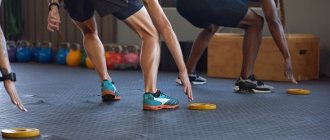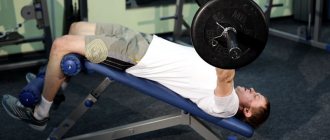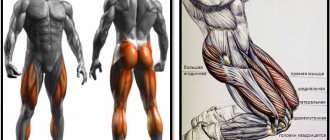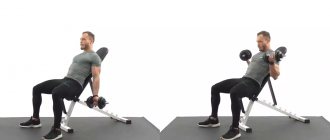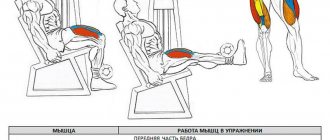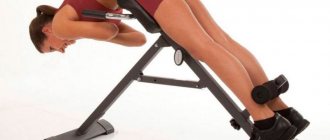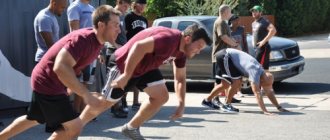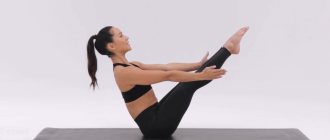Running is one of the natural, one might say, non-fictional sports disciplines.
It has been known since ancient times as a natural method of transportation, used in the most important areas of human life and everyday life: hunting, war, to quickly cover long distances. One of the varieties of running, shuttle running, is an indispensable element of training in various sports: we’ll talk about it in the article.
Among the mass of its advantages of a purely sporting nature, there is also a purely practical one - it can be practiced in the gym, for example, if outdoor training is hampered by weather conditions.
- Information sheet
- Beneficial features
- Shuttle running: execution technique
- Shuttle running standards
- Sneakers: how to choose shoes for shuttle running
- Contraindications
What's happened
Shuttle running is a special section of interval cardio training, which consists of repeating running at high speed with a turn. It is done for short distances. Let's take a closer look:
- interval training: takes place in a circular interval mode (periods with a certain load);
- cardio: performed in a heart rate range of at least 120, and ideally the cardio corridor is calculated: the heart rate range in which you train aerobically;
- repetition of short-distance running with a turn: shuttle running occurs over a short distance, but with a constant turn of 180 degrees and repetition of the races, as if in a circle.
- Put everything together: you get a shuttle run!
A workout is usually referred to by two numbers: the first indicates the number of repetitions (circles), and the second indicates the length of the distance in meters. For this option, short distances are usually used: 3, 10, 15 meters; a 100-meter race is extremely rarely prescribed.
What is the benefit
Shuttle running is an excellent way to “raise” the condition of the heart, lungs and muscles to the level of almost army training, because it was there that this type of exercise arose at the very beginning and gave rise to the growth of the sports direction. This type of running strengthens blood vessels and increases endurance.
For those who want to lose weight, this is an ideal way to shed pounds. With regular exercise, they simply fly away. Also a pleasant bonus is the simplicity of the equipment: you can exercise in the gym and on the street at a short distance.
In addition to influencing the body’s systems, exercise improves metabolism: fat loss accelerates, and the metabolism itself becomes more intense. The body is provided with oxygen with this type of load.
Standards
It is worth noting that the standards for 10x10 shuttle running are different for each category of citizens. Standards have been developed for students of schools, universities and military personnel depending on gender and age.
| Name of exercises | Up to 25 years | From 26 to 30 years old | From 31 to 35 years old | From 36 to 40 years | From 41 to 45 years old | From 46 to 50 years | From 51 to 55 years old | 56 years and older |
| Shuttle run 10*10 m (sec.) | 28,8 | 29,6 | 30,3 | 30,8 | 31,6 | 34,2 | 38,2 | 41,2 |
Who shouldn't
Such running is a serious load that not everyone can afford. There are some conditions and illnesses where you should not run. These include:
- hypertonic disease;
- ischemic disease;
- serious rhythm disturbances;
- injuries of the musculoskeletal system, as well as anatomical changes: hernia, protrusion, etc.;
- pregnancy and breastfeeding;
- vascular lesions of the arteries and veins of the brain;
- period after stroke and heart attack;
- acute inflammatory process, including infectious;
- uncontrolled bronchial asthma;
- complicated diabetes mellitus;
- severe breathing problems.
If there is reason to suspect any of the above, you should immediately go to the doctor. He will conduct an examination and help you cure the problem in time and adjust your training.
Contraindications
Like most physical exercises, this type of running has certain contraindications:
- heart diseases;
- hypertonic disease;
- problems with the joints, especially the ankle.
Shuttle running, as already mentioned, is an excellent exercise for training agility, endurance and coordination of movement, and can be used to test athletes. It is included in the physical training program of most professional athletes.
But the distinctive feature of this type is that anyone can do it, developing and training all of the above qualities. Moreover, apart from a flat surface and sneakers, it does not require any other equipment.
How to run
Shuttle running consists of several phases:
- Warm-up: necessary to prepare the heart, blood vessels, lungs and muscles, should take at least 10-15 minutes. It usually includes simple general strengthening exercises, moderate-intensity running or walking, and in some cases, special running exercises to develop technique.
- Stretching: This can be used to complete the warm-up and the entire workout. In the first case, 2-3 exercises on the muscles of the lower extremities are suitable, and in the latter, you should carefully stretch the entire body.
- Direct running: it consists of circular repetitions - 10 times 10 m with a turn. First come the commands - to start, attention, march. At this time, you need to take the correct posture and group your body for the upcoming load.
You shouldn’t take breaks between laps - they move into each other without stopping, and by the last lap you need to speed up, on the contrary. The technique of execution does not depend on the number of repetitions.
An important trick is to distribute your forces correctly! Don't start running with maximum effort. As practice shows, about 60% of the energy is spent on the last laps, so you need to save yourself for the final push. Each lap occurs with a slight acceleration.
Let's look at all the stages briefly.
Exercises to improve results
It is necessary to talk about some recommendations for improving running results and typical mistakes that are typical when fulfilling the shuttle running standard.
By eliminating these errors, you will certainly improve your results:
- Incorrect distribution of forces over the distance, especially for exercises with a large number of segments (6x10-10x10). Having given all your efforts in the initial stage, you often don’t have enough energy for a strong finish.
- You should not abuse excessive loads. Training should be enjoyable, and not deplete the body by loading it with work in extreme conditions (unless, of course, you are a professional athlete during a physical training camp).
- Slowing down before turning in the opposite direction. Through training, you will learn to turn around in one motion, using the inertia of your body to accelerate yourself. This is not easy, but correct implementation of this element will significantly improve your performance.
- Breathing is a very common cause of poor results. Although the importance of this element has already been mentioned above, it is not superfluous to recall: breathing should be in resonance with the step (for example, 2+2). You should breathe in combination (nose and mouth), although many experts recommend exclusively nasal breathing. Experiment with this component of running.
- Spend enough time warming up. The muscles should be well warmed up and the ligaments should be stretched.
- Training should be regular (every other day), take place at approximately the same time and load the body with approximately the same intensity. This situation should not be allowed: today you train at half strength, and tomorrow you do 150% of your usual loads. Such training will bring nothing but negativity.
If you want to radically improve your results in shuttle running, you should train running and its elements - start and turn. The specificity of this exercise is such that no other physical exercise is similar to it.
On the contrary, shuttle running is one of the basic physical training exercises in many sports, especially team sports - wherever you need a powerful jerk at the start and a sharp, almost instant finish, requiring precise coordination and reaction: football, hockey, basketball, rugby, handball and others.
Find out how to start running today.
In traditional types of running, speed in the sprint, endurance in the marathon and the combination of these two qualities in distance races are crucial. A person’s speed has a limit and depends largely on genes (the ability to run) and physical data.
We can say that in shuttle running, speed matters less than execution technique. Here, an athlete who has a well-established start and turn technique, who tactically correctly distributes his forces, can easily win against an opponent who is much faster in a straight line.
Important! A typical jog burns about 300 calories in 30 minutes. That is, by running solely for your own pleasure, without straining, you completely “get rid” of eating 100 g of biscuit or half a bar of milk chocolate.
Warm-up
For a good warm-up you should:
- Walk on a treadmill at a moderate pace for 10 minutes or jog;
- do exercises: squats, leg swings to the side, lunges, body bends, shoulder and arm rotation, jumping rope;
- you can include practicing the starting position and running for 5, 10 and 15 meters with a turn, as well as running with a high hip for a short distance or running for a distance of 60-80 m with acceleration.
A combination of general strengthening and running exercises will prepare the body for the main section.
Shuttle run
Running consists of stages:
- Take the correct pose : place your supporting leg forward, and move the second (flying) leg back a little (on average, a distance of 2-3 feet), your legs should be completely on the surface. The body needs to be moved forward with the weight: the center of gravity will be above the front leg, and the arms should be lowered along the body. This is the team - let's start!
- Command attention: here you need to bend your arms at the elbow joints and move them forward and along the body (arms and legs are opposite), and tilt the body forward until parallel with the surface, you can also place your hand above the swing leg on the floor. A light springing force should be felt in the body, and at this time the swing leg goes to the toe.
- March command: push yourself forward with your swing leg, helping with your hands. They should be kept bent, but the fingers should be straight, this will increase the speed. While running, maintain a breathing rhythm: 2 movements - inhale, then 2 more - exhale (2 steps during each breathing movement).
- Run with acceleration : as you approach the line, slow down a little and turn around, place your foot perpendicularly, lift your leg over the line and turn 180 degrees. When running, you need to maintain an inclination of the body: imagine that you are dribbling a ball;
- The last lap must be run with maximum acceleration.
pros
This principle of training is beneficial in that it has a beneficial effect on the body, namely:
- Improves the functioning of the cardiovascular system.
- Blood circulation and metabolic processes improve.
- Weight loss.
- Immunity increases.
- Toxic substances are removed.
- Relieves fatigue.
Also contributes to the development of:
- Strength.
- Dexterity.
- Feelings of balance.
- Coordination.
- Motor skills.
- Speed qualities, etc.
Because of such versatile benefits, it began to be used in many types of martial arts, crossfit, and fitness.
Technical details
To understand how to improve your training, listen to your body and experience: all the secrets are in mastering the technique and yourself! But both indicators can be developed. If this is your first training, then pay due attention to the lead-in exercises for training posture and turn: 5, 10 and 15 meters. They need to be done at an average pace with short stops when turning. During real running, there is no need to stop there - this will reduce the speed and impede inertia.
Also, you shouldn’t immediately strive to run exactly 10/10. Start with lower yardage and repetitions: 4 times 9 meters. You can then increase the distance to 15 and 20 meters, maintaining 4 repetitions. And only after a month and a half, move on to the full-fledged 10/10 option.
After completion, do not stop abruptly - walk or jog at an average pace for a few more minutes so that the blood is distributed correctly. Then you can stop and drink some water.
Errors
When performing such training, mistakes often occur:
- incorrect posture: a straight back, arms pressed to the body and not working, a pinched cervical spine will lead to pain;
- incorrect breathing rhythm: fatigue will set in quickly;
- slowing down before turning: loss of speed and efficiency;
- explosive running in the first laps: you won’t have enough strength for the last time;
- very large steps: you need to take medium or even small steps in order for the running to be really fast;
- sudden loads of high intensity: they will harm not only the desire, but also the ability to train, the same applies to very frequent training: 3-4 times a week;
- land on your heel: you need to land on your toes;
- keep your legs straight: knees and all joints should be softened;
- turning the foot with a pause: you need to turn your body and legs in a single movement.
To avoid such failures, you need to work with a trainer first. Shuttle running is an element of professional sports, and it requires a professional and deep approach!
